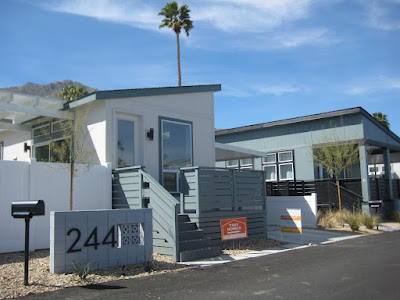Raw land for development is very scarce in Palm Springs and has been for years. Several years ago, some venturesome developers latched on to a new approach to the problem. They decided to take an aging trailer park in the south end of town and bring in new modular units; rebuilding the area from the asphalt streets and up. They seem to have succeeded well beyond their initial intentions.
Even with the pandemic shutting down businesses for quite a while, buyer interest never waned and now the park is almost completely finished with new modular units throughout. One of their secrets was to push the modernism style in everything they did - design wise.
Fans of mid-century architecture are drawn to Palm Springs because of the plethora of original and redesigned mid-century homes here. It’s a ‘modernism’ mecca for design aficionados and those who want to return to the simpler times of the late 1940s and early 50s.
Since
‘Modernism Week’ began almost fifteen years ago in Palm Springs, the legions of
McM fans keeps growing and interest exploding. Yet there is a subtle truth lurking
just below the surface of all of this excitement. The fact that few folks can
actually afford to live in one of those mid-century treasures…until now.
That real estate disparity slowly began changing with the refurbishing of the old trailer park, an extended land lease and some imaginative architecture. Palm Canyon Mobile Club is a completely remodeled mobile home community with its newly-built ‘modern micro-homes in a not-so-tiny package.’ Homes started at around $115,000 for a one bedroom plus an average of $650 per month space rental. It’s become one of the newest clubs in town for McM addicts.
I tell friends that there are three things to remember about real estate here in California. First, this is California real estate so it doesn’t have to make sense relative to the rest of the country. Secondly, this is Southern California real estate which means it can get even crazier than other parts of the state. Finally this is Palm Springs real estate which is a unique hybrid in itself. If you understand anything about the housing market you could probably guess that California housing is an entirely different breed of animal.
In addition, studies have shown that the millennials’ demand for a new type of neighborhood has led to the emergence of ‘Urban Suburbs.’ Those are defined as high-density neighborhoods in suburban areas that share a number of urban qualities such as walkability and nearby amenities such as shopping, restaurants, etc. North Palm Springs is starting to attract this kind of development as well as other parts of the country too.
There
is a new cluster of tiny homes being built outside of Atlanta. The Clarkston development will be the first
neighborhood of homes under 500 square feet to be sold in Georgia. Other metro
projects are to follow with 40 tiny homes being built in South Fulton and
another in the Pinewood Forest in Fayetteville.
Creating new housing designs that complement the surroundings here is nothing new for Palm Springs. Beginning in the mid-40s, architects originated a design movement specific to the greater Palm Springs area. It became known as Desert Modern. Their buildings featured groundbreaking techniques such as post-and-beam supports, floor-to-ceiling glass walls and a wide array of colors to match the surrounding mountains and desert. These were homes meant for the very few who could afford them and their tony locations in the desert. Now one developer’s solution to that exclusivity lies in a century old model that’s been around for ages…the mobile home.
The Palm Canyon Mobile Club was originally built in the early 1960s. The location was ideal. It was close to shopping, restaurants & bars, and offered its residents some of the best mountain views around. The park was one of the rare few to allow all ages, not just seniors.
In late 2016, the master lease for the
park was purchased and the ground lease was extended 65 years which provided
security for the park's future. Then the developers began to bring a new vision
to the Palm Springs Mobile Club with their own version of the tiny home.
The developer’s idea was to take your standard mobile home park and turn it into a desert enclave of tiny homes. They’ve taken the old reliable double-wide mobile home and turned one half of it into a tiny home. Of course, being Palm Springs it couldn’t be just any half of a doublewide. The developer and designers have used the cantilevered roof line as an architectural statement and designed amenities that both complement and enhance the main structure.
With nine-foot ceilings throughout, plus clerestory windows and sliding glass doors, the homes are flooded with natural light. There are one and two bedroom homes, ranging in size from 600 to 900 feet. It’s single level living with full sized appliances and room for a washer and dryer. There are some private fenced yards, a lot of outdoor decks and select front porches.
The center of the community is "The Club," featuring a newly remodeled club house; updated resort style pool area which includes an outdoor fire pit and lounge areas, plus barbecue area. A work-out room, pool table, plus updated poolside bathrooms and sitting areas are part of the club house features.
This new housing concept has certainly taken hold and portends more radical changes to mobile home parks throughout the Coachella Valley. Palm Springs has always had a wide variety of housing from single family homes, duplexes, condominiums, cooperative housing, senior housing, mobile home parks, apartments, vacation rental properties and VRBOs.
Now tiny homes are edging their way
into the marketplace. It will be interesting to see if they take hold and how
price appreciation compares to other types of housing.
Only in Palm Springs.

















No comments:
Post a Comment